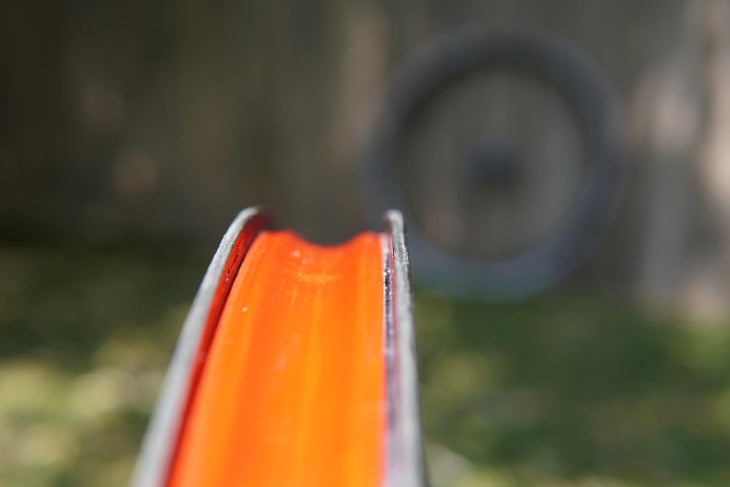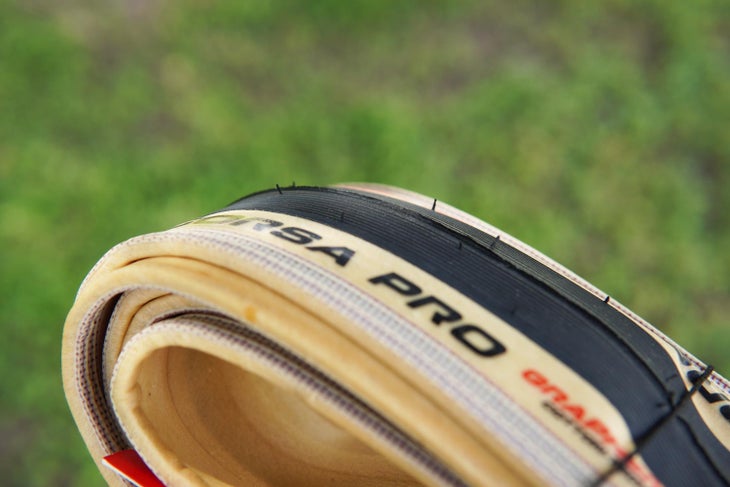Road tubeless, is it for everyone, and does it mean the end of the bicycle tube? The simple and fast answers are no and no. However, road tubeless is the future of the sport, but it isn’t without its complexities and a bit of a learning curve.
The road market is finally figuring out that air pressure and air volume are more important than we realized. It isn’t without confusion since we have been told that skinnier tires at higher pressures are faster for decades. While that may have been true at that time, like everything else in this evolving world, technology, manufacturing improvements, and real-time testing have changed what was once fact. So what has all of this modern tech taught us? We have recognized that adding volume and reducing pressure offers significant performance advantages with minimal aerodynamic drag increase. In many cases, it has actually improved aerodynamics and reduced the total system drag.
For a very long time and still to this day, many component companies test and design each product in isolation. While this can help expedite, bicycles are a system, and each component needs to complement the total system. In the case of a wheel, this means the wheel might be optimized on its own but not optimized on a bike or even when you add a tire or change the size of the tire. Components like wheels are a dynamic system, and new testing protocols mean they get tested in the way they will be used with measurable data, not subjective opinions.

This has led to the adaptation of bigger tires with more air volume at lower pressures. Not only does this yield more traction, safety, and compliance but a faster and more aerodynamic total system. This is important because that is how we ride, as a total system, not just a set of wheels with tires mounted to them. It doesn’t matter how aero a wheel is if it doesn’t complement the rest of the system.
I think it is important to point out that the “old” belief that you needed 110psi wasn’t wrong. When you calculate the air volume and pressure needed to support an average rider using a 23mm tire on a 14mm internal width rim, you will need around 105-110psi. What has changed is that we are adding volume through internal rim width and tire size. As the volume increases, the optimal pressure decreases. One might ask, if it is so much better, why didn’t we do it sooner?
The real reason it took so long for road to go tubeless
One of the biggest reasons road bikes didn’t transition to tubeless when mountain bikes did in the early 2000s was tire size and brakes. In 1999 the tubeless mountain bike rim and tires were launched, and it didn’t take long to become the standard. Back then, mountain bikes had been booming, and there was what seemed to be endless amounts of money getting dumped into the sport. So why didn’t road bikes jump on the new advancements? The road market has always prioritized speed, and big tires don’t offer the same “feeling” of speed that super skinny tires do. Essentially they didn’t look and feel fast, so there was no way they were.
As time passed and science and computer tech evolved, so did our understanding of speed. However, it didn’t matter how they mixed things up. There was a major limitation to the evolution of road wheels and tires, the rim brake track. Seems silly, but the rim brake or, more importantly, its reliance on the wheel limited the evolution of wheel design. Wheels need to be built to withstand not only the dynamic loads of a moving bicycle but also needed to be robust enough to act as a crucial safety device as they are part of the brakes. Not a big deal if you want a reliable wheel, and weight is taken out of the equation, but if you want to advance the sport and increase performance, wheels are the best place to make significant changes.

Bicycle designers started looking at mountain bike wheels and wondering why their carbon wheels were stronger, much lighter, and had fewer failures overall while in much more harsh environments. It was simple. Removing the added complexities of the rim being an oversized rotor allowed them to optimize road wheels for weight and aerodynamics while moving the braking to its own component, the rotor. This is why the road disc and road tubeless seemed to hit the market almost simultaneously. Disc brakes offered the freedom to transform the wheel so much.
The removal of the rim brake track, and the evolution of wheel design, aerodynamics, and performance, have been on a rocketship of changes ever since. So, why and how did we so quickly get road tubeless? Because mountain bikes had already done most of the work, we just had to get out of our own way and let the old ways go. Wider rims can now fit in the same frame dimensions because rim brake pads don’t need to squeeze into either side. This means volume increases, and less pressure is required to support the same amount of weight. At the same time, it offers increased safety with a larger tire contact patch and, by removing the friction of a tube, reduces rolling resistance.
In short, the entire wheel market has evolved more in six years than it has since 1975 when Mavic launched a hooked rim.

When to use tubes
Before we get too far, I want to point out that tubeless isn’t for everyone. First, if your wheels and/or tires are not tubeless compatible, you should never attempt to retrofit them. There are specific tolerances needed to run road tubeless safely. The next is if you have a bike that rarely gets used, tubeless is probably not the most ideal system. Since most tubeless systems rely on a liquid sealant, a bike that sits unused for a long period of time is more likely to have tires that are not pressurized. When left unpressurized for too long, the tubeless sealant can be compromised, and the liquid will then dry up, leaving it useless. To summarize, stick to tubes if your equipment is not tubeless-ready or if it goes unused for long periods of time.
The devil is in the details
Now that we understand the changes, what are the important details that cyclists need when trying to determine the ideal pressure? Internal rim width is a key aspect to increase volume as well as optimize performance for larger road tires. 25-32mm tires should pair with a rim that is at least 19mm wide internally. For the majority of riders, a 21-25mm internal width will be ideal and offer the most versatility.
Tubeless compatibility is next, with some wheels using a hooked bead design, while many brands transition to a hookless design. In reality, if you are running a tubeless tire, they will work with both designs. If you want to use a tube-type tire, you will need to get a wheel with a hooked bead. If you have a wheel with a hookless design, you MUST run a tubeless tire, even if you are using a tube in the system. For all tubeless systems, there is a maximum “safe” pressure of 75psi.
In reality, you should always choose a rim width and tire size that keeps you at least 5psi below 75psi or lower. All hookless wheel systems have this same limit, and even with a tube, it should never exceed 75psi since there is no mechanical advantage.
It should also be noted that no matter if you have a tube or a tubeless system if your volume increases, your pressure needs to drop. It is about volume, not system type. A 28mm tube-type tire mounted to a 21mm internal rim with a tube installed only needs about 1-2psi more pressure than a tubeless 28mm tire on the same 21mm rim. The use of a tube and a hooked bead does not mean you should increase pressure more.
Should I ride road tubeless tires? My take
At the end of the day, it is about improving not only performance but safety and reliability. I know many of you are lucky enough to have well-maintained and flawless roads, but for the rest of us, riding in the gutter and debris is a reality. Tubeless not only minimizes flats, but it also makes crap roads a bit more enjoyable. Since completely transitioning to road tubeless, I can count on one hand the number of flats I have had in the last four years.
When I had tubes, I couldn’t make it through a week without at least five to six flats. Yes, I know Los Angeles roads are notoriously bad and undermaintained, but it is what I ride. For the racers, it means you can dive more confidently into a turn and pedal through road imperfections. That means more time with the power to the ground and less time worrying about the road so you can keep your focus on the competition and race dynamics.
Road tubeless isn’t for everyone, but it is probably much better than you realize. The first few rides at a lower pressure take some getting accustomed to if you have been rolling around at over 100 psi, trust me. It will only take a few rides for you to see the difference. What I like to do is take people down their favorite twisty decent. Normally they say it felt slower, but looking at their time, they are always faster. The added traction improves control so much that you feel like it is easy. See if a local shop has a set of tubeless wheels you can try for a few rides before you make the investment.

